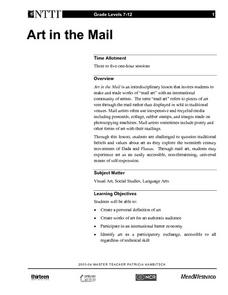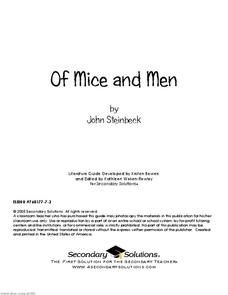US Institute of Peace
Perspectives on Peace
Is peace simply the absence of war, or is there more to the story? Young social scientists define peace in the second installment of a 15-part series. Groups work together to explore cultural concepts of peace and the peacemaking process...
Curated OER
The Outsiders
Are you working on an Outsiders unit? Use this list of activities to deepen your middle schoolers' understanding of the novel. After reading S.E. Hinton's novel, young readers work on three required activities, including participating in...
Curated OER
Express Yourself Lesson Seed 12: Story Event
Focus on plot and the impact-specific events in The Cay. Class members use their double-entry journals, created in a previous lesson in this series, to record their thinking about the guiding question as they read chapters 15 through 17....
Curated OER
Art in the Mail
The "mail art" phenomena was started back in the 20's with the Dada and Fluxus art movements and revitalized in the 60's. The principle of mail art, is free exchange and artistic expression. Learners study these facts and then create...
Curated OER
Jeffrey and Sloth: Six Traits of Writing
Use drawings as inspiration. Have learners doodle for 10 minutes before beginning the lesson. Then, have them use their doodles to inspire a story. Several writing activities are included here to play with writing. One of my favorites...
Curated OER
Cartoons for the Classroom: Sarcasm, Irony, and Satire
Satire, sarcasm, or irony? Editorial cartoons have long been the tool artists use to express their opinions about politics and politicians. Kevin "Kai" Kallaugher's four-panel cartoon offers readers an opportunity to examine how he uses...
Curated OER
What Makes a Novel a Novel?
They always say to write what you know. This approach is used to get middle schoolers prepared to write novels of their own. Using a favorite book as a model, potential novelists respond to prompts that ask about characters, plot, main...
Curated OER
Word Pair Analogies 7: Low-Advanced Level (SAT)
Consider pairing up your pupils and having them work together on a set of analogies. Learners are directed to form bridge sentences that express the relationship between the first pair of words. Partners could then use this sentence as a...
Curated OER
Introduce Vocabulary: Ruby the Copycat (Rathmann)
Have your scholars ever known someone who was a copycat? Approach this issue as you study vocabulary in context by reading Peggy Rathmann's book Ruby the Copycat. Proposed focus words are: recite, murmur,...
La Jolla High School
Of Mice and Men by John Steinbeck: In Search of Figurative Language
While this resource was originally made to be used in conjunction with John Steinbeck's Of Mice and Men, it could be used for any literary text. A reference sheet for readers, the resource includes terminology related to figurative...
Prestwick House
Catcher in the Rye Activity Pack
The Catcher in the Rye is the focus of a sampler that models some of activities included in a for-purchase packet based on J. D. Salinger's novel.
Secondary Solutions
Of Mice and Men: A Literature Guide
Whether you are planning on using Of Mice and Men for whole-class reading or as a selection for literature circles; whether you are new to John Steinbeck's novel, or it has long been a part of your curriculum, you...
EngageNY
Making a Claim: Moon Shadow’s Point of View of the Immediate Aftermath
Body paragraphs are the building blocks of every essay. Pupils view and discuss a model essay using a rubric to evaluate one of its supporting paragraphs. Next, scholars use what they've learned to continue drafting their own literary...
Curated OER
Lightning Lesson Plan
Students explore how to read scientific material by reading about the research being conducted by Dr. Rob Cifelli from the Colorado State University.
Curated OER
Scientific Literacy - Lightning
Students investigate how radar can be used to determine the lightning potential of a cloud. Several readings are provided about the research conducted by Dr. Rob Cifelli. The scientific material is summarized in this instructional activity.
Curated OER
Poetic Devices
In this figurative language worksheet, pupils read and study examples of simile and metaphor. There are 20 questions to be used with Smartboard and 10 questions in which students identify similes or metaphors.
Curated OER
Creating a Collage
Fifth graders identify and describe the characteristics of collages. They familiarize themselves with the history of collage making. They select pictures from magazines that relate to their chosen word of the week. They design a collage.
Curated OER
Paradise Lost: Identifying Vocabulary
“The mind is its own place. . .” and Milton’s Paradise Lost is sure to expand the vocabulary (and the minds) of young readers. Assist that growth with an activity that asks individuals to first select and define five unfamiliar words,...
Curated OER
Understanding Character
Readers practice character analysis by reviewing Gary Soto's short story "La Bamba" with the whole class (anything you've read together will work). They design t-shirts that feature traits and story elements to reveal the nature of a...
Shmoop
ELA.CCSS.ELA-Literacy.RL.11-12.4
Your assessment is to figure out if I am being figurative or connotative with this statement: This is a great resource. Can’t do it? Then you had better review how to break down Common Core skill RL.11-12.4. In simple language that you...
Curated OER
Developed or Undeveloped?
Students watch slides of other countries to identify and discuss factors that make a country developed or developing. They create a product that shows their view of developed and undeveloped.
Curated OER
Genres, Genres Everywhere
Young readers assume the role of Genre Sleuths to investigate the characteristics of folktales, fantasies, and mysteries. For this session you will need to collect a variety of books on a topic you have been studying. Groups then examine...
Curated OER
Symbiosis: Help, Hinder or Destroy
Use background information and vocabulary to familiarize your students with the concept of symbiosis and the role agriculture plays in the shared relationship. They then write the vocabulary in their lab books or journals, and read the...
Curated OER
Know Yourself
Eleventh graders explore the events of the Holocaust. For this cross curriculum lesson, 11th graders examine the differences between prejudice and discrimination. Students read various forms of literature and write...

























